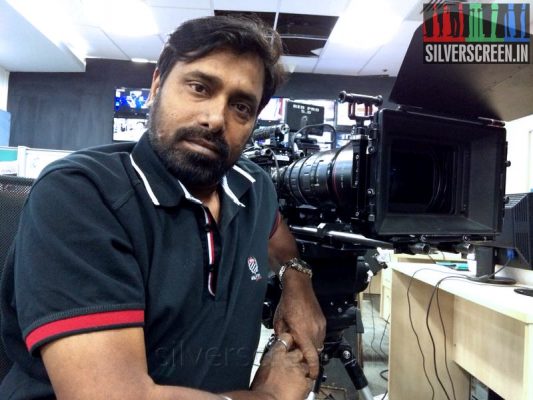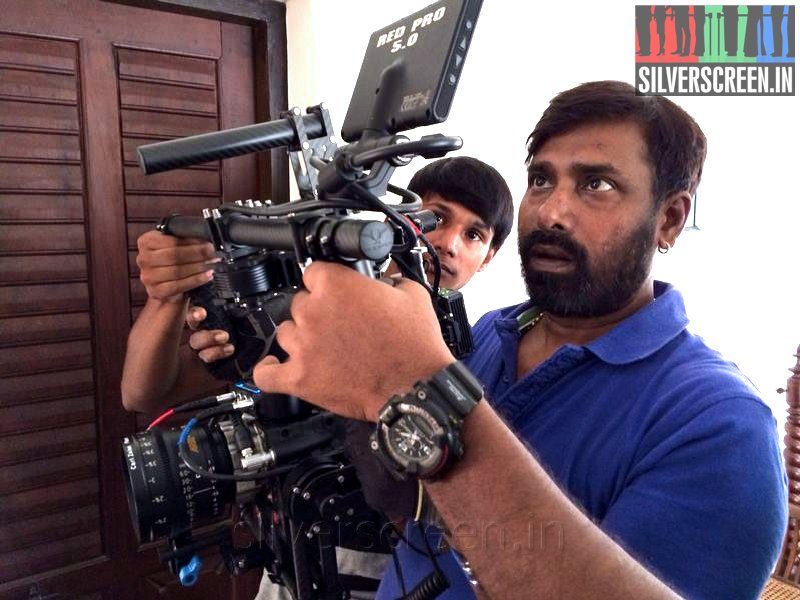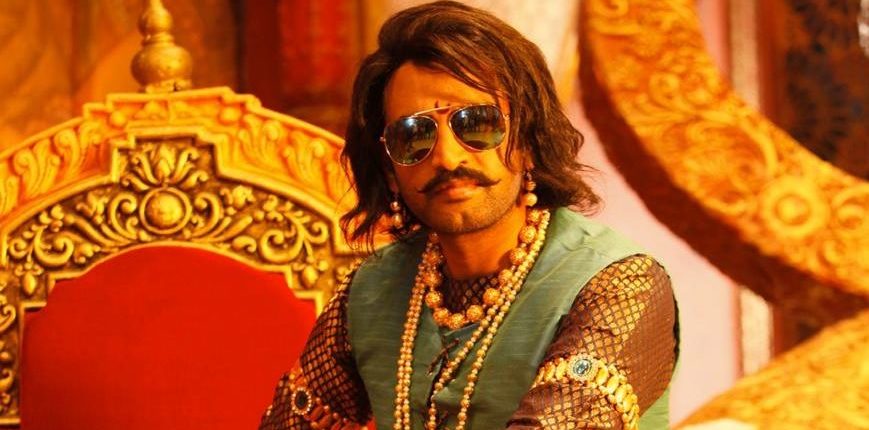Cinematographer RD Rajasekhar has come a long way from his days as an assistant to Rajiv Menon in Bombay. As he gears up for his next release, Arima Nambi, he talks us through the method and madness behind his craft.
RD Rajasekhar still recalls the first and perhaps the most invaluable piece of advice he got in his two decade-long career. He was on one of the earliest assignments of his career, assisting Rajiv Menon on the sets of Mani Ratnam’s Bombay, and they were filming the Uyire song in persistent drizzle. As is customary for such shots, Rajasekhar was shooting with a filter. “Suddenly Rajiv sir asked me to shoot without the filter,” he tells me, “and the effect was mind-blowing as the frame turned into a lovely greyish blue. It remains one of the most beautifully-picturised romantic songs of our times.” That day, he learnt the most important theory of his craft – break the rules, and you get extraordinary results.
[quote align=’right’]Imagine wasting your time searching for a white towel for hours[/quote]Now on his 23rd film as a cinematographer – an action film called Arima Nambi starring Vikram Prabhu and Priya Anand – Rajasekhar is still learning on the job. He loves doing action movies, because the terrain lets him experiment. But the perfect action film starts with a sensible script – “Action sequences are based on the descriptions of the director. Only then can you can add thrill to the frames. Music and cinematography are crucial elements,” he tells me, before starting to talk excitedly about his craft. “The shots should be of the same level and length.You can’t afford to have loose frames or compositions in an action film…lensing is particularly important – zoom back, trolley in, all shots that bring in the audience involvement.” He is all praise for the “technically sound” debutant director of Arima Nambi – Anand Shankar, who used to assist AR Murugadoss. The movie, which he shot mostly in Chennai and Bangkok, “has a powerful screenplay.”
The one thing he is very clear about is working with “like-minded directors” as the director’s whole vision is executed by the cinematographer. He gives a few instances – Murugadoss with whom he did Ghajini “likes to explain what he wants at the shooting spot as he is also the scriptwriter”, Lingusamy (Bheema) “explains things precisely, gives you a very visual image, prefers rehearsals before a shot” while Prabhu Deva (Vedi) “starts from the 34th shot and is well-planned.” He goes on to talk more about his association with Prabhu Deva – “Sometimes Prabhu sir likes to start from deep close-ups and go for long shots, which is challenging for a cinematographer as it is easy to manage lighting if you start from the long shots.”
[quote align=’left’]That day, he learnt the most important theory of his craft – break the rules, and you get extraordinary results[/quote]His big break came with Gautham Menon’s Minnale (2001), followed by Kaakha Kaakha (2003) and its Telugu remake, Gharshana a year later. He recalls his association with the director – “He lets you improvise a lot on the sets, asks for suggestions and is good at getting the best out of you.” Rajasekhar thinks Menon has an uncanny ability to find the perfect backdrop to film romance, his favourite genre – “If you notice he likes to use lots of blues, pinks and silhouettes there. They have an inimitable charm,” he admits, before he delves into lighting. “I love to shoot at night, because there is better control over lighting and helps me capture silhouettes better,” he gushes. And another thing he loves? Filming eyes, as they have a “lot to tell.” He used to use an Arriflex 435 earlier, but has switched to the Red Epic Dragon post the digital invasion. Like most of his contemporaries he prefers the ultra-prime and Cooke 5i prime lenses.
Does he get a bound script before a shoot? “Ideally that’s the way it should work. But in Tamil it doesn’t happen every time. If I get it, I take 15-20 days to read it and visualise it. It is important that I understand the screenplay in detail,” he tells me, before explaining how the different film industries work. “Malayalam cinema for instance is constrained by budget, so they plan well and spend a lot of time on writing. They lock their scripts down before shooting which you don’t see in Tamil cinema. Telugu follows a similar style.”
He is currently in Kochi shooting for a Malayalam film, Avatharam, starring Dileep and Lakshmi Menon, and helmed by one of his favourite directors, Joshi. Soon after, he will join Venkat Prabhu’s untitled film with Suriya.

Cinematographer R D Rajasekhar
He rates Kaakha Kaakha high on his favourites list for two reasons – the captivating way it moves, “with the camera acting as two eyes in the film,” and Suriya. “We were shooting the climax near Egmore, on a bridge. I was focusing on Suriya’s blood shot eyes and then, in a split second he is out of the frame. He had fallen off the bridge. It would have been fatal,” he recalls with a shudder. Billa 2 is special as it was the first film he shot in a digital camera – “We used a Red Epic digital camera with a S1 lens. Chakri Toleti, the director, got it for us from the US.”
A good production house is as crucial to a film as a good script and a capable director – “A good banner will be able to bring together a solid technical team on board. Picking the wrong technicians or actors can ruin a good script. Half your job is done if you have a good editor and a solid screenplay,” he tells me. His biggest grouse? “It has to be that long wait for actors to get ready. Then, missing props. Imagine wasting your time searching for a white towel for hours! Everything suggests bad planning in such cases.”
Though he admits cinematography has primarily got to do with technical expertise, he doesn’t buy the theory that it’s just about that –“Learning on the job is what matters in the end. I watch countless films at any given point of time and keep reading this book on American cinematography, which is like a bible for me,” he admits. Rajasekhar also has a word of caution for those from his tribe who are gearing up for direction –“Don’t do both. Let go of one to get better results.”
An alumnus of the Adyar Film institute, he tells me that he learnt everything about his craft from his mentor Rajiv Menon, with whom he worked for 8 years. He particularly remembers their first film together, where he and Ravi K Chandran worked together- Girish Karnad’s Cheluvi that told the story of a girl who has mystical powers to turn into a tree. During Menon’s Minsara Kanavu, he worked as the 1st assistant director, with Ravi K Chandran handling the camera – “Rajiv sir wanted me to do dabble in all aspects of filmmaking, right from dubbing to post production. He always told me not to let go any opportunity that comes your way. You never know when you will get that career defining film.”
Surprisingly, he lists the not-so-discussed work of Santosh Sivan in MF Hussain’s Meenaxi as his favourite, even more than the iconic Thalapathy – “That was more stylish. Meenaxi had a terrific palate of muted shades and uniformity was maintained throughout.” He cites Inception and Inglorious Basterds for their imaginative cinematography.
Recommended
Does he enjoy doing ad films, I interject on a tangent. Of course he loves them – he has done over 600 of them – “You have to get 20 shots in 20 seconds. It’s a huge challenge and good money,” he grins.
And finally, what about Bollywood where many of his compatriots are doing well? “Dhoom 3 was offered to me initially, but it kept getting delayed so I opted for a Telugu film. I would love to do something in that genre in Bollywood. The reason why we are the most-wanted people in Bollywood is because we are hardworking, patient, technologically proficient and less money-minded than those working there,” he states wryly. Also, helps if you are as good at it as he is.
The RD Rajasekhar Interview is a Silverscreen.in Exclusive



